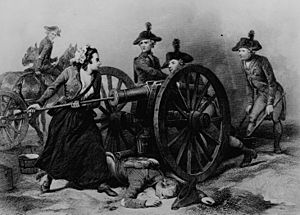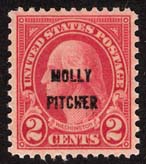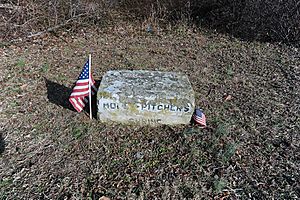Molly Pitcher facts for kids
Molly Pitcher is a legend from the Revolutionary War. She was bringing pitchers of water to men working a cannon. When one of the men fell down, she fired the cannon herself.
Historians do not think there was a real person named "Molly Pitcher" in the Revolutionary War. Most historians agree it was a nickname. They think the story of Molly Pitcher may have come from more than one real woman who fired a cannon. Many of the battles were fought on hot days, and soldiers would ask for a pitcher of water to drink or to cool the cannons. Molly was a common woman's nickname at the time.
Contents
History of the legend
Stories about the American Revolution were first told by talking out loud instead of writing them down. This allowed the storyteller to make things sound bigger than they were or even make up things that did not happen at all. Some stories are still told, long after professional historians prove they are not true.
The story of Molly Pitcher may have come from more than one real person. Many women helped soldiers on the battlefields during the Revolutionary war. Most were wives and daughters of soldiers. According to the legend, "Molly Pitcher" brought water to a group of soldiers firing a cannon during a battle. One of those soldiers was her husband. She brought water many times. When she came to bring water one time, she saw her husband had been shot. Molly took his place and helped fire the cannon. The Battle of Monmouth is probably where the legend started.
Her story was started many years after the war by writers and artists. A Currier and Ives print of a "Captain Molly" appeared in 1848. The first writing about Molly Pitcher was in 1859. It wasn't until 1876 that someone published a genealogy claiming a local woman was the real Molly Pitcher. After that, the idea of Molly Pitcher grew and grew.
Today, Molly Pitcher is famous. She is in grade-school and high-school textbooks. Internet sources even argue whether Molly Pitcher was a feminist.
The real women
Most legends start with some small truth. Molly Pitcher is no exception. There are several women who might have been the real Molly Pitcher, or it might have been all of them together:
- Mary Ludwig Hayes (also called Mary Ludwig Hayes McCauley) is in records on June 28, 1778. This is when she signed up to serve with the Pennsylvania Artillery. She may have earned the nickname "Molly Pitcher" by bringing drinking water to soldiers in the heat at the Battle of Monmouth. When her husband had heat stroke or was wounded, Mary took his place on the artillery piece. The legend says she was personally thanked by George Washington after the battle, but this might not be true. Washington made a comment during the battle, recorded by Dr. William Read. Washington said that he was admiring the manner in which Proctor was handling their right. He was referring to Captain Francis Proctor's artillery company. Mary Hays was the wife of a gunner in that company. The Battle of Monmouth started the myth of Mary Pitcher. The state of Pennsylvania gave her a pension of forty dollars forty years after the battle for her heroism.
- Margaret Corbin was serving with her husband at Fort Washington in present day New York City. Her husband John fell wounded and later died, and she took his place at the cannon. She was hit by three rounds of grapeshot in her arm. She was captured by the British but returned to the Americans at a Philadelphia hospital. She continued to serve, doing whatever she could even though she was injured. Her arm never healed and she was given a half-soldier's pension in 1779 for the rest of her life.
- Deborah Sampson at 5 feet 8 inches was a tall woman. She dressed as a man and served with the 4th Massachusetts Regiment. Because she had a good-looking face, the other men (thinking she was also a man) called her "Molly" as a joke. She served for the rest of the war. Sampson was the only other woman who received a federal pension for military service. She had tried once before to join the army in 1782 by disguising herself as a man. She collected a bounty for enlisting as "Timmothy Thayer." She was caught the following day and had to return the money.
The Revolutionary war had many small fights and only a few large battles. It was not unusual for women to be fight. Women filled many roles that most people thought were only done by men.
A written account
Joseph Plumb Martin was a soldier in the Continental Army. He wrote down of his experiences. This came to the attention of historians in the 1950s. Martin describes a woman at the Battle of Monmouth:
A woman whose husband belonged to the Artillery, and who was then attached to a piece in the engagement, attended with her husband at the piece the whole time; while in the act of reaching a cartridge and having on of her feet as far before the other as she could step, a cannon shot from the enemy passed directly between her legs without doing any other damage than carrying away all the lower part of her petticoat,—looking at it with apparent unconcern, she observed, that it was lucky it did not pass a little higher, for in that case it might have carried away something else, and ended her and her occupation.
This account has been changed in other sources to show he gave her a name when in fact he did not.
Commemorations
Federal
In 1928, "Molly Pitcher" was honored with an overprint reading "MOLLY / PITCHER" on a United States postage stamp. Earlier that year, festivities had been planned to celebrate the 150th anniversary of the Battle of Monmouth. Stamp collectors petitioned the U.S. Post Office Department for a commemorative stamp to mark the anniversary. After receiving several rejections, New Jersey congressman Ernest Ackerman, a stamp collector himself, enlisted the assistance of the majority leader of the House, John Q. Tilson. Postmaster General Harry New steadfastly refused to issue a commemorative stamp specifically acknowledging the battle or Molly Pitcher. In a telegram to Tilson, Postmaster New explained, "Finally, however, I have agreed to put a surcharged title on ten million of the regular issue Washington 2¢ stamps bearing the name 'Molly Pitcher.'"
Molly was finally pictured on an imprinted stamp on a postal card issued in 1978 for the 200th anniversary of the battle.
"Molly" was further honored in World War II with the naming of the Liberty ship SS Molly Pitcher, launched, and subsequently torpedoed, in 1943.
The stretch of US Route 11 between Shippensburg, Pennsylvania, and the Pennsylvania-Maryland state line is known as the Molly Pitcher Highway.
The Field Artillery and Air Defense Artillery branches of the US Army established an honorary society in Molly Pitcher's name, the Honorable Order of Molly Pitcher. Membership is ceremoniously bestowed upon wives of artillerymen during the annual Feast of St. Barbara. The Order of Molly Pitcher recognizes individuals who have voluntarily contributed in a significant way to the improvement of the Field Artillery community.
The U.S. Army base Fort Liberty holds an annual event called "Molly Pitcher Day," showcasing weapon systems, airborne operations, and field artillery for family members.
Other
- The State of Tennessee offers their women veterans a license plate honoring their service. The plate depicts Molly Pitcher, recognizing women in combat from the beginnings of the nation.
- Molly Pitcher Inn is a hotel in Red Bank, New Jersey, not far from the site of the Battle of Monmouth.
- Molly Pitcher Service Area is a rest area on the New Jersey Turnpike (I-95) in Cranbury, New Jersey.
- The Molly Pitcher Stakes is an American Thoroughbred horse race raced annually during the last week of August at Monmouth Park in Oceanport, New Jersey.
- The Molly Pitcher Club was a short-lived women's anti-prohibition organization in New York state.
- The Molly Pitcher Brewing Company is located in Carlisle, PA.
Images for kids






